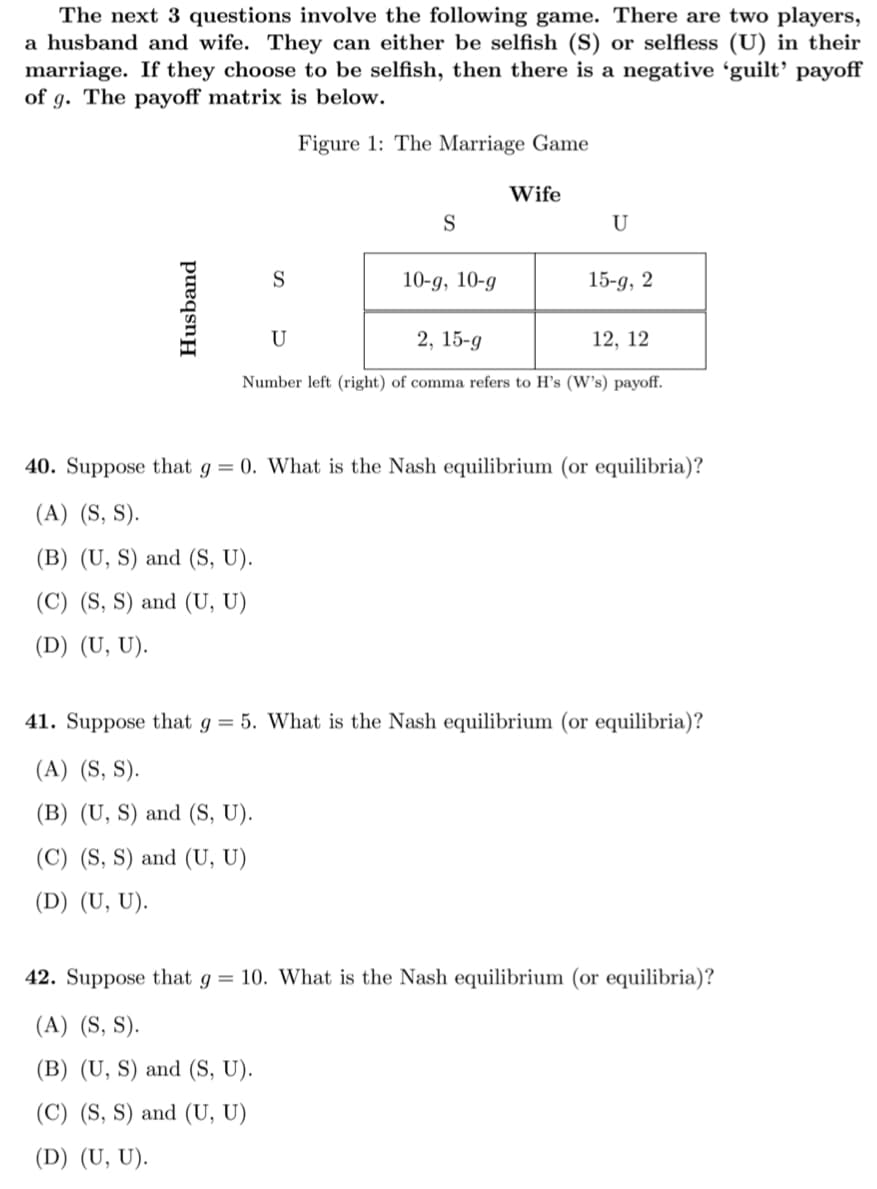The next 3 questions involve the following game. There are two players, a husband and wife. They can either be selfish (S) or selfless (U) in their marriage. If they choose to be selfish, then there is a negative ʻguilt’ payoff of g. The payoff matrix is below. Figure 1: The Marriage Game Wife S U S 10-g, 10-g 15-g, 2 U 2, 15-g 12, 12 Number left (right) of comma refers to H's (W's) payoff. 40. Suppose that g = 0. What is the Nash equilibrium (or equilibria)? (A) (S, S). (B) (U, S) and (S, U). (C) (S, S) and (U, U) (D) (U, U). 41. Suppose that g = 5. What is the Nash equilibrium (or equilibria)? (A) (S, S). (B) (U, S) and (S, U). (C) (S, S) and (U, U) (D) (U, U). 42. Suppose that g = 10. What is the Nash equilibrium (or equilibria)? (A) (S, S). (B) (U, S) and (S, U). (C) (S, S) and (U, U) (D) (U, U). Husband
The next 3 questions involve the following game. There are two players, a husband and wife. They can either be selfish (S) or selfless (U) in their marriage. If they choose to be selfish, then there is a negative ʻguilt’ payoff of g. The payoff matrix is below. Figure 1: The Marriage Game Wife S U S 10-g, 10-g 15-g, 2 U 2, 15-g 12, 12 Number left (right) of comma refers to H's (W's) payoff. 40. Suppose that g = 0. What is the Nash equilibrium (or equilibria)? (A) (S, S). (B) (U, S) and (S, U). (C) (S, S) and (U, U) (D) (U, U). 41. Suppose that g = 5. What is the Nash equilibrium (or equilibria)? (A) (S, S). (B) (U, S) and (S, U). (C) (S, S) and (U, U) (D) (U, U). 42. Suppose that g = 10. What is the Nash equilibrium (or equilibria)? (A) (S, S). (B) (U, S) and (S, U). (C) (S, S) and (U, U) (D) (U, U). Husband
Chapter8: Game Theory
Section: Chapter Questions
Problem 8.1P
Related questions
Question

Transcribed Image Text:The next 3 questions involve the following game. There are two players,
a husband and wife. They can either be selfish (S) or selfless (U) in their
marriage. If they choose to be selfish, then there is a negative ʻguilt’ payoff
of g. The payoff matrix is below.
Figure 1: The Marriage Game
Wife
S
U
S
10-g, 10-g
15-g, 2
U
2, 15-g
12, 12
Number left (right) of comma refers to H's (W's) payoff.
40. Suppose that g = 0. What is the Nash equilibrium (or equilibria)?
(A) (S, S).
(B) (U, S) and (S, U).
(C) (S, S) and (U, U)
(D) (U, U).
41. Suppose that g = 5. What is the Nash equilibrium (or equilibria)?
(A) (S, S).
(B) (U, S) and (S, U).
(C) (S, S) and (U, U)
(D) (U, U).
42. Suppose that g = 10. What is the Nash equilibrium (or equilibria)?
(A) (S, S).
(B) (U, S) and (S, U).
(C) (S, S) and (U, U)
(D) (U, U).
Husband
Expert Solution
This question has been solved!
Explore an expertly crafted, step-by-step solution for a thorough understanding of key concepts.
Step by step
Solved in 2 steps

Knowledge Booster
Learn more about
Need a deep-dive on the concept behind this application? Look no further. Learn more about this topic, economics and related others by exploring similar questions and additional content below.Recommended textbooks for you


Managerial Economics: A Problem Solving Approach
Economics
ISBN:
9781337106665
Author:
Luke M. Froeb, Brian T. McCann, Michael R. Ward, Mike Shor
Publisher:
Cengage Learning

Exploring Economics
Economics
ISBN:
9781544336329
Author:
Robert L. Sexton
Publisher:
SAGE Publications, Inc


Managerial Economics: A Problem Solving Approach
Economics
ISBN:
9781337106665
Author:
Luke M. Froeb, Brian T. McCann, Michael R. Ward, Mike Shor
Publisher:
Cengage Learning

Exploring Economics
Economics
ISBN:
9781544336329
Author:
Robert L. Sexton
Publisher:
SAGE Publications, Inc

Microeconomics: Principles & Policy
Economics
ISBN:
9781337794992
Author:
William J. Baumol, Alan S. Blinder, John L. Solow
Publisher:
Cengage Learning